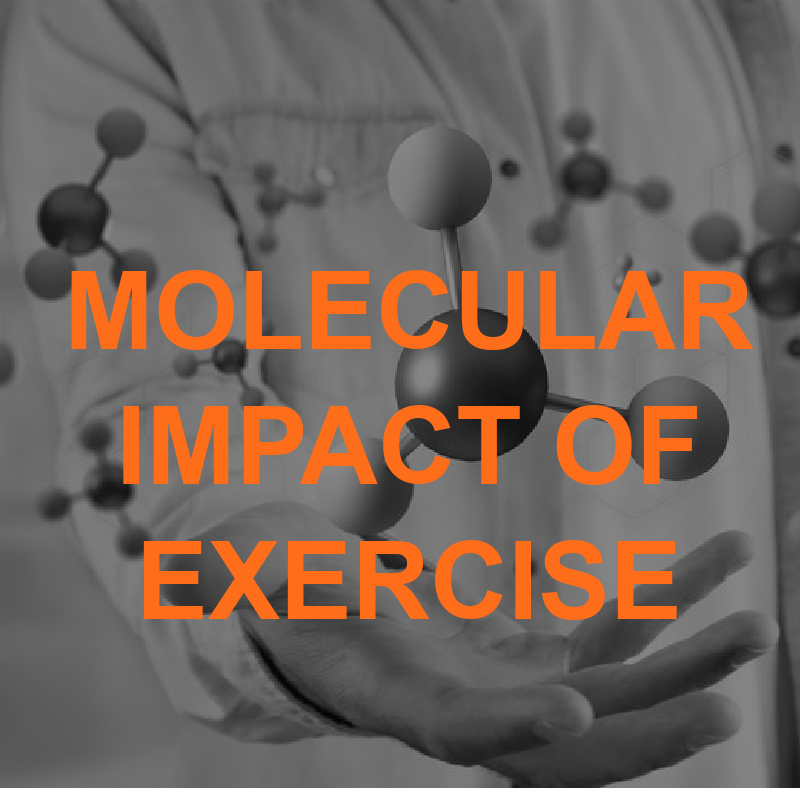
Clients often inquire about the value of a short workout when schedules and commitments must take precedence over their usual training session. After finding out the individual’s goals, I like to underscore the importance of doing something, however briefly, is always better than sitting on the couch doing nothing. I may also provide the common litany of aesthetic benefits that exercise confers to the body: improvements in body composition, burning fat, cultivating lean muscles, better fitting clothes, etc. But the benefits are farther reaching than that, which we all sort of accept, but the depths of which have not been fully delved, specifically with regard to molecular changes.
Molecular Morphology
Progress such as this, achieved over a training cycle or two, typically defines what most individuals seek to derive from their workouts — the positive changes visible to the eye. However, the list of accolades attributed to exercise does not end there. A veritable cascade of positive, interactive events occur that the gym-goer cannot see: the ones occurring at the molecular level.
The study of “-omics” delves deeply into exercise-induced molecular changes and how they affect the human body. The term “-omics” addresses the complex synchronicity of every gene, protein, and/or metabolic by-product in the body, in this case post-exercise. By simply attaching this suffix to the cell in question, scientists delineate specific bodily systems. As an example, metabolomics researchers look at the metabolic state of a cell, striving to understand these molecular alterations. In a likewise fashion, proteomics encompasses the function and interactions among proteins.
Short Workouts Reveal Stunning Results
One such study, the results of which appeared in the well-respected journal Cell, recruited 36 volunteers to walk/run on a treadmill for 10 minutes. After drawing a pre-workout blood sample for purposes of comparison, the volunteers tried to reach their peak exercise capacity throughout the 10 minutes. Upon completion, the researchers collect blood at 2 minutes post-exercise, 15 minutes, half an hour, and finally one full hour later.
Regardless of the fact that the treadmill work only lasted 10 minutes, it appeared to have brought on well over 9,000 discernible alterations in molecules throughout the subjects’ bloodstreams. Among so many other changes, the immune system ramped up in response to the brief episode of exercise. Oxidative stress experienced by the body was another pathway that demonstrated positive effects.
Dr. Michael Snyder, Chairman of Stanford University’s genetics department and primary author of the article, shared his thoughts on the significant changes following the 10-minute treadmill session: “You’re getting such a dramatic change when you exercise and it’s something that permeates throughout your entire system. We think it’s a global regenerator, if you will. It’s a global boost and there aren’t that many things that can give you that.” Clearly, a workout need not last an hour for an individual to derive these molecular changes in the blood.
The Molecular Mapping Model
We have come to accept and promote the idea that exercise, in general, helps older adults live longer, healthier, and more productive lives. Now, armed with the preliminary information detailed in Dr. Snyder’s article, the world of molecular investigation with respect to physical training seems to have found a place in the scientific mapping arena.
A very unique organization known as the Molecular Transducers of Physical Activity Consortium (MoTrPAC) came together with the sole purpose of creating a molecular “map” of sorts, utilizing data gleaned from clinical studies. Referring back to the earlier discussion of -omics, this consortium analyzes and maps an extensive variety of such parameters as they relate specifically to exercise.
The studies do not limit themselves to any particular age demographic; rather, these researchers include exercisers who span the ages. The team also regards similarities and differences between the roles played by both aerobic exercise and strength training. This leads fitness professionals to believe that upon completion of such a molecular map, the public may gain a better understanding of the subtle yet powerful changes occurring deep within their human cells and tissues.
Future Study of Disease Prevention
In addition to tracking the proteomics and immune responses to exercise, much focus has been placed on “metabolites”, or by-products of cellular metabolism, brought about post-workouts. It comes as no surprise, especially to personal trainers, that skeletal muscle displays significant changes in response to weight-bearing exercise. Upon closer examination, scientists have found positive changes in the cells’ mitochondria, often nicknamed “the powerhouse of the cell,” correlating with changes in cardiometabolic fitness.
Understanding how bouts of brief yet intense exercise induce metabolic changes may pave the way for a greater understanding of cardiovascular disease. Such results open the door to future pharmacologic experimentation and the development of newer, more effective treatment options.
Different Experiment, Same Positive Data
In yet another experiment, scientists analyzed urine samples obtained from 23 highly-conditioned soccer players before and after participation in HIIT exercises. Focusing on metabolome and proteome arenas, the resulting data reflected changes in amino acid synthesis as well as metabolic by-products. Numbers culled from the proteome study indicated changes relating to energy metabolism, immune system function, and again, oxidative stress, similar to the observations made by Dr. Snyder and his colleagues.
One scientist summed up his research results by stating that “Exercise is probably the most important thing to help healthy aging. It really is a systemic effect.” If this sounds like advice we routinely dispense to our clients, trainers may now feel even more confident in such a prescription, especially when addressing reluctant or deconditioned individuals. After all, we should all find it hard to ignore 9,000 positive molecular changes!
References:
www.sciencedaily.com/releases/2020/05/200528115826.htm
worldhealth.net/news/exercise-alters-molecules-blood/
www.cell.com/cell/pdf/S0092-8674(20)30691-7.pdf
www.nytimes.com/2020/11/25/well/move/exercise-omics.html
www.ahajournals.org/doi/10.1161/CIRCULATIONAHA.120.050281
pubmed.ncbi.nlm.nih.gov/20505214/
pubmed.ncbi.nlm.nih.gov/25091629/
med.stanford.edu/news/all-news/2020/05/stanford-medicine-study-details-molecular-effects-of-exercise.html
pubmed.ncbi.nlm.nih.gov/32470399/
alttox.org/mapp/emerging-technologies/omics-bioinformatics-computational-biology/
pubmed.ncbi.nlm.nih.gov/32760941/








